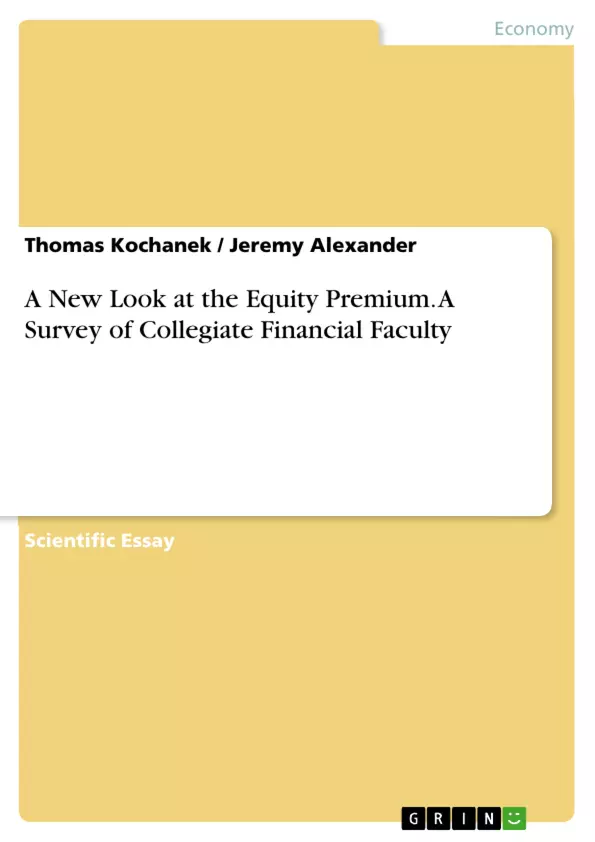This paper deals with the difference of potential returns of diverse assets within a long-term period. Recent articles investigated an unexplainable abnormality of long term returns of stocks in comparison to risk-free securities even if stocks were risk- adjusted. This phenomenon is called the Equity Premium Puzzle.
With this paper we want to investigate how current investors make use of the disclosures of these papers. Since one assumption of capital markets is that any information is available to any investor in the world, any investor who invests on a long term basis would act irrational if she invests within the bond market, while she could earn a lot more money in the stock market. Furthermore this fact of the existence of not rational acting investors might show that capital markets are not that efficient as expected or information among investors are not shared sufficiently through markets as an earlier study showed.
In our study we created a questionnaire of about 22 questions. All questions which were applied were held superficially, so that the respondent had no clue which goal we were looking for with that survey. We distributed our questionnaire to all available investors of all different ages. However we tried to focus on those investors with a long time investment horizon, such as students, pupils or early workers in the end 20’s or less. Since the Equity Premium Puzzle is not only a national issue, we did our survey not only in the United States of America but also in Germany.
Inhaltsverzeichnis (Table of Contents)
- The Paper
- Research on the Equity Premium
- Explanations for the Equity Premium Puzzle
- Empirical Evidence and Survey Results
- Conclusions
Zielsetzung und Themenschwerpunkte (Objectives and Key Themes)
This paper explores the equity premium puzzle, investigating the disparity between the returns of stocks and risk-free securities over long periods. The study aims to analyze how financial professionals perceive and utilize this phenomenon in their investment decisions. The paper leverages a survey of finance professors to gain insights into their assumptions and opinions regarding the equity premium.
- Equity Premium Puzzle
- Investor Behavior and Rationality
- Market Efficiency and Information Sharing
- Risk Premium and Investor Expectations
- Empirical Evidence and Explanatory Theories
Zusammenfassung der Kapitel (Chapter Summaries)
- The Paper: This section introduces the paper's purpose and context, outlining the survey of finance professors and its relevance to the ongoing debate surrounding the equity premium puzzle. The study is positioned within the context of prior research by Fama and French (2001), Shiller (2000), and Welch (2001), which explored investor opinions and market dynamics related to the equity premium.
- Research on the Equity Premium: This chapter delves into the historical research on the equity premium, examining its varying values across different time periods and countries. Studies by Shiller (1989), Dimson (2000), Mehra & Prescott (1985), Brealey & Myers (1996), and Claus & Thomas (2001) are reviewed to showcase the range of estimated equity premium values in the US and other developed economies.
- Explanations for the Equity Premium Puzzle: This chapter explores prominent theoretical explanations for the equity premium puzzle. It discusses the role of utility in consumer consumption patterns as a potential driver of the phenomenon, citing research by Epstein & Zin (1989, 1991) that highlights the significance of covariance with market returns and consumption growth in shaping investment decisions. Additionally, the chapter explores the concept of habit formation as a possible explanation, referencing the work of Constantinides (1990) which argues that utility is influenced by past consumption levels.
- Empirical Evidence and Survey Results: This section presents the results of the survey conducted among finance professors, providing insights into their perceptions and utilization of the equity premium puzzle in their investment strategies. The chapter highlights the survey's methodology, including the questionnaire design and the selection of participants. It explores the findings related to the awareness of the equity premium among the respondents and their intentions to incorporate it into future investment decisions. The chapter also discusses the potential impact of the survey results on stock prices and returns, emphasizing the need for further research to understand these dynamics.
Schlüsselwörter (Keywords)
This paper explores the equity premium puzzle, investor behavior, market efficiency, risk premium, investor expectations, and various theoretical explanations for the phenomenon. The research draws upon historical data, empirical studies, and a survey of financial professionals to gain a comprehensive understanding of this complex issue.
- Citar trabajo
- Thomas Kochanek (Autor), Jeremy Alexander (Autor), 2007, A New Look at the Equity Premium. A Survey of Collegiate Financial Faculty, Múnich, GRIN Verlag, https://www.grin.com/document/118324



